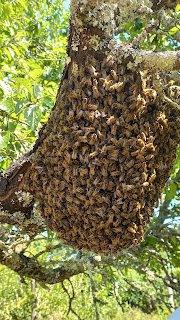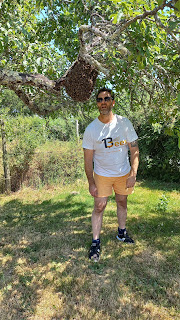Earlier in the summer we collected a few swarms of bees that did not make for easy work! We might share a few of the stories once the scars have healed but for now we'd love to share a positive story (it helps with our therapy 😂😂😂). Last month, on
a sunny morning, we received a call from a couple who had noticed a large group
of bees in one of their plum trees. We asked them to send a photo so we could
assess it and yes, they were right, a swarm cluster had formed on a branch. It
was almost text-book in its size, shape, and position, perfect for collecting
and re-homing in a hive.
Off we went with our ‘swarm kit’ consisting of a collecting box, a hive, a large white sheet, a queen clip, a smoker, and some lure (lemon balm), to meet the property owners who were fascinated by the bees and asked if they could observe the capture (from a safe distance, of course!). The bees were immediately identified as Buckfast bees, a hybrid strain made up of bees from Italy, France, and Eastern Europe i.e. a desirable mix of productive, calm, hardworking, and hardy characteristics.
This cluster was calmly waiting on the tree branch, ready to move to its new home once the scouts had agreed and communicated its location. Our job was to get them into our hive before they took off again. We still couldn’t quite believe that this job was going to be that easy but, for the first time in a long time, we didn’t need ladders or a scaffold tower to reach the cluster as the branch was only a couple of metres from the ground. We set up the hive on a small stand, with a ramp up to the entrance, and spread the white sheet out in front of it. Then we took our cardboard box, positioned it under and around the cluster, gave the branch a sharp shake, and listened to the satisfying thump as the majority of the bees fell into the box. This is what is supposed to happen and almost never does as most of the bees usually fly up and out. We quickly closed the box flaps, carried it over to the white sheet, and gently tipped the bees out, and again, surprisingly, they stayed with only a few flying around.The next stage was to play the beekeeping version of “Where’s Wally?”, trying to find the queen bee in amongst 30,000 other similarly-striped insects. We had our queen clips ready, small cages in which to hold the queen safely, and started to look for her. In our experience she is frequently at the back of the crowd, so we scrutinised that area, prepared for it to take several minutes. However, within seconds she was spotted and carefully captured. We placed her inside the hive and almost immediately the bees picked up her pheromone and moved towards her, walking quickly up the ramp and into the hive. It is an incredible sight and one we never tire of witnessing; it’s almost something of a party-piece, seeing winged insects walking rather than flying! Within an hour all the bees from the cluster were inside the hive, with a few foragers still in the air. As it was only mid-afternoon at this stage we left the hive open to allow the bees to fan pheromones to communicate the position of their new home, and when we returned after dark, all the bees that had originally swarmed were inside the hive. We closed it up and took it to our quarantine apiary.
A few days later we inspected the new colony to assess its health and to ensure it had settled in to its new home. Continuing the theme of doing exactly what is expected, the bees had already built new comb and the queen had begun laying, with eggs and small larvae easily visible. Pollen and nectar was also being stored, proving that the foragers had found a good source of nutrition. Every now and again bees DO read the same books as beekeepers!



No comments:
Post a Comment